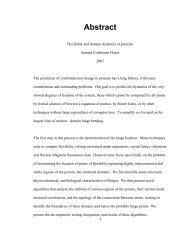The Real Life of Pseudogenes Disabled genes, molecular - People
The Real Life of Pseudogenes Disabled genes, molecular - People
The Real Life of Pseudogenes Disabled genes, molecular - People
Create successful ePaper yourself
Turn your PDF publications into a flip-book with our unique Google optimized e-Paper software.
Differences in pseudo<strong>genes</strong><br />
<strong>of</strong>fer hints about<br />
diverse life histories.<br />
ranging from bacteria to more complex<br />
organisms, such as yeast, worms, flies<br />
and mice, and their prevalence across a<br />
wide range <strong>of</strong> creatures is striking. <strong>The</strong><br />
number <strong>of</strong> pseudo<strong>genes</strong> in different genomes<br />
varies greatly, more so than <strong>genes</strong>,<br />
and it is not readily predictable, because<br />
it is neither strictly proportional to the<br />
size <strong>of</strong> a genome nor to the total number<br />
<strong>of</strong> <strong>genes</strong>. Comparisons <strong>of</strong> pseudo<strong>genes</strong><br />
in related genomes can nonetheless reveal<br />
important information about the<br />
history <strong>of</strong> specific <strong>genes</strong> and the general<br />
workings <strong>of</strong> <strong>molecular</strong> evolution.<br />
One <strong>of</strong> the largest known gene families<br />
in mammals, for example, consists<br />
<strong>of</strong> more than 1,000 different <strong>genes</strong> encoding<br />
olfactory receptors, the cell-surface<br />
proteins that confer our sense <strong>of</strong><br />
smell. Detailed analyses <strong>of</strong> olfactory receptor<br />
(OR) <strong>genes</strong> and pseudo<strong>genes</strong> by<br />
Doron Lancet and Yoav Gilad <strong>of</strong> the<br />
Weizmann Institute <strong>of</strong> Science in Rehovot,<br />
Israel, show that humans have lost a<br />
large number <strong>of</strong> functional olfactory receptor<br />
<strong>genes</strong> during evolution, and we<br />
now have fewer than 500 <strong>of</strong> them in our<br />
genome. For comparison, versions <strong>of</strong><br />
about 300 human olfactory receptor<br />
pseudo<strong>genes</strong> are still functional <strong>genes</strong> in<br />
the genomes <strong>of</strong> rats and mice.<br />
This difference is not surprising given<br />
that most animals depend more for<br />
their survival on the sense <strong>of</strong> smell than<br />
humans do. In fact, humans have considerably<br />
more olfactory receptor pseudo<strong>genes</strong><br />
than chimpanzees do, indicating<br />
that we lost many <strong>of</strong> those functional<br />
<strong>genes</strong> after our split from the ape<br />
lineage. Apes, however, have a higher<br />
proportion <strong>of</strong> olfactory receptor pseudo<strong>genes</strong><br />
(30 to 40 percent <strong>of</strong> the OR family)<br />
than rodents or dogs do, suggesting<br />
that some influence has allowed the entire<br />
ape lineage to get by with a somewhat<br />
reduced sense <strong>of</strong> smell.<br />
Lancet and his colleagues found in<br />
studies <strong>of</strong> apes, monkeys and other distant<br />
primate cousins that the greatest<br />
loss <strong>of</strong> olfactory receptor <strong>genes</strong>—that is,<br />
the greatest increase in OR pseudo<strong>genes</strong>—occurred<br />
in ape and monkey lineages<br />
that evolved the ability to see color<br />
in three wavelengths <strong>of</strong> visible light. <strong>The</strong><br />
link may suggest that a sensory trade-<strong>of</strong>f<br />
took place over time in the primate lineage<br />
when better eyesight made an acute<br />
sense <strong>of</strong> smell less critical.<br />
Often, <strong>genes</strong> involved in an organism’s<br />
response to its environment are<br />
subject to extensive duplication and diversification<br />
over time, leading to large<br />
gene families, such as the olfactory receptor<br />
repertoire. Many dead-on-arrival<br />
pseudogene copies are an immediate byproduct<br />
<strong>of</strong> this process. But the subsequent<br />
death <strong>of</strong> additional duplicates,<br />
which gives rise to new pseudo<strong>genes</strong>, is<br />
also frequently connected to changes in<br />
an organism’s environment or its circumstances.<br />
Consequently, differences<br />
T H E A U T H O R S<br />
in the pseudo<strong>genes</strong> <strong>of</strong> animals <strong>of</strong>fer hints<br />
about their diverse life histories that are<br />
not as easily detected in comparisons <strong>of</strong><br />
working <strong>genes</strong>, which are strongly constrained<br />
by their function.<br />
Analysis <strong>of</strong> the mouse genome, for<br />
example, has shown that 99 percent <strong>of</strong><br />
human <strong>genes</strong> have a corresponding version<br />
in the mouse. Although the human<br />
and mouse lineages diverged some 75<br />
million years ago, nearly all <strong>of</strong> the human<br />
genome can be lined up against equivalent<br />
regions, known as syntenic blocks,<br />
in the mouse genome. Yet despite this<br />
similarity in functional <strong>genes</strong> and overall<br />
genome structure, just a small fraction<br />
<strong>of</strong> the known human pseudo<strong>genes</strong> have<br />
an obvious counterpart in the mouse.<br />
What is more, some <strong>of</strong> the specific<br />
gene families giving rise to pseudo<strong>genes</strong><br />
differ significantly between mouse and<br />
human. Using the rate <strong>of</strong> sequence decay<br />
relative to the parent <strong>genes</strong> to determine<br />
their age, it is also clear that many pseudo<strong>genes</strong><br />
in the human and mouse genomes<br />
have arisen at different times.<br />
<strong>The</strong>se observations indicate that very<br />
disparate events have led to independent<br />
bursts <strong>of</strong> retrotransposition that created<br />
pseudo<strong>genes</strong> in each <strong>of</strong> the lineages.<br />
MARK GERSTEIN and DEYOU ZHENG are bioinformaticians at Yale University, where Gerstein<br />
is A. L. Williams Pr<strong>of</strong>essor <strong>of</strong> Biomedical Informatics and co-director <strong>of</strong> the Yale<br />
Program in Computational Biology and Bioinformatics. Zheng, after completing his Ph.D.<br />
at Rutgers University, joined Gerstein’s group in 2003 to begin investigating pseudogene<br />
activity and evolution. Both authors were initially interested in studying <strong>molecular</strong><br />
structure and simulation, as described in Gerstein’s previous article for Scientific American<br />
with Michael Levitt, “Simulating Water and the Molecules <strong>of</strong> <strong>Life</strong>” (November 1998).<br />
But Gerstein and Zheng were intrigued by the enormous data analysis challenges posed<br />
by the sequencing <strong>of</strong> the human genome and chose to start scanning and sifting the<br />
regions <strong>of</strong> DNA between <strong>genes</strong>.<br />
w w w. s c i a m . c o m S C I E N T I F I C A M E R I C A N 53<br />
COPYRIGHT 2006 SCIENTIFIC AMERICAN, INC.










